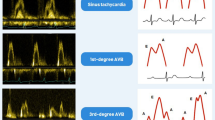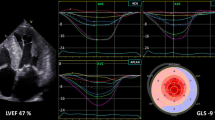Abstract
Background
Vector Flow Mapping (VFM) and Energy Loss (EL) evaluation are emerging echocardiographic techniques that offer detailed insights into cardiac function. This study aimed to explore the relationship between EL parameters and B-type natriuretic peptide (BNP) levels, a well-established marker of heart failure severity.
Methods
Our study prospectively enrolled 62 patients experiencing shortness of breath and suspected heart failure, who underwent echocardiography and had BNP levels measured between January 2018 and August 2020. Patients were stratified based on BNP levels, and their clinical and echocardiographic characteristics were evaluated. Univariate and multivariate regression analyses were performed to assess the correlation between BNP levels and various echocardiographic variables, including VFM parameters.
Results
Patients were stratified into two groups based on their BNP levels: BNP < 200 pg/ml (n = 53) and BNP ≥ 200 pg/ml (n = 9). Patients with BNP ≥ 200 pg/ml presented significantly different clinical and echocardiographic characteristics, such as older age, larger left ventricular mass and volume indices, higher pulmonary artery systolic pressure, higher E/e’ ratio, and larger EL parameters. Multivariate regression analysis demonstrated the E/e’ ratio and ELA (EL during Atrial contraction phase/A wave ratio as significant determinants of logBNP. Receiver operating characteristic curve analysis showed ELA/A > 36.0 J/m2 as a significant predictor of high BNP with 89% sensitivity and 85% specificity. ELA/A demonstrated an incremental diagnostic value over elevated left atrial pressure for predicting high BNP (C statistic = 0.98 vs 0.74, P = 0.006).
Conclusion
This study provides novel insights into the potential utility of EL parameters as auxiliary indicators of cardiac load, thereby enhancing our understanding of heart failure.




Similar content being viewed by others
Data availability
Data are available on reasonable request.
Abbreviations
- VFM:
-
Vector flow mapping
- EL:
-
Energy loss
- BNP:
-
B-type natriuretic peptide
- LV:
-
Left ventricular
- LA:
-
Left atrial
- ELS:
-
EL during systolic phase
- ELE:
-
EL during early diastolic phase
- ELA:
-
EL during atrial contraction phase
References
Roth GA, Abate D, Abate KH, Abay SM, Abbafati C, Abbasi N, et al. Global, regional, and national age-sex-specific mortality for 282 causes of death in 195 countries and territories, 1980–2017: a systematic analysis for the Global Burden of Disease Study 2017. The Lancet. 2018;392:1736–88.
Kramer CM, Barkhausen J, Bucciarelli-Ducci C, Flamm SD, Kim RJ, Nagel E. Standardized cardiovascular magnetic resonance imaging (CMR) protocols: 2020 update. J Cardiovasc Magn Reson. 2020;22:1–18.
Li Y, Zhang L, Gao Y, Wan X, Xiao Q, Zhang Y, et al. Comprehensive assessment of right ventricular function by three-dimensional speckle-tracking echocardiography: comparisons with cardiac magnetic resonance imaging. J Am Soc Echocardiogr. 2021;34:472–82.
Frommelt P, Lopez L, Dimas VV, Eidem B, Han BK, Ko HH, et al. Recommendations for multimodality assessment of congenital coronary anomalies: a guide from the American Society of Echocardiography: developed in collaboration with the Society for Cardiovascular Angiography and Interventions, Japanese Society of Echocardiography, and Society for Cardiovascular Magnetic Resonance. J Am Soc Echocardiogr. 2020;33:259–94.
Zhu H, Cheng C, Yin H, Li X, Zuo P, Ding J, et al. Automatic multilabel electrocardiogram diagnosis of heart rhythm or conduction abnormalities with deep learning: a cohort study. Lancet Digital Health. 2020;2:e348–57.
Daimon M, Iwano H, Onishi T, Ohara T, Tanaka H, Hirano Y, et al. Guideline from the Japanese society of echocardiography: guidance for the management and maintenance of echocardiography equipment: 2022 focused update. J Echocardiogr. 2022;20:195–200.
Nyrnes SA, Fadnes S, Wigen MS, Mertens L, Lovstakken L. Blood speckle-tracking based on high–frame rate ultrasound imaging in pediatric cardiology. J Am Soc Echocardiogr. 2020;33(493–503): e5.
Daae AS, Wigen MS, Fadnes S, Løvstakken L, Støylen A. Intraventricular vector flow imaging with blood speckle tracking in adults: feasibility, normal physiology and mechanisms in healthy volunteers. Ultrasound Med Biol. 2021;47:3501–13.
Becker KC, Cohen J, Nyce JD, Yau JL, Uppu SC, Sengupta PP, et al. Age-related changes in left ventricular vortex and energy loss patterns: from newborns to adults. Am J Physiol Heart Circul Physiol. 2023;324:H624–9.
Pugliese N, Del Punta L, Falcetta G, Besola L, De Biase N, Mazzola M, et al. Evaluation of energy loss in patients with severe primary valvular heart disease before cardiac valve intervention. Eur Heart J Cardiovasc Imag. 2022;23(jeab289):356.
Adabifirouzjaei F, Igata S, Kahn AM, Strachan M, DeMaria AN. Assessment of Diastolic Energy Loss in Hypertensives versus Controls. J Am Soc Echocardiogr. 2022;35(1190–2): e3.
Chen X, Wang Y, Wang W, Yuan L, Qi Z, Song D. Assessment of left ventricular energy loss using vector flow mapping in patients with stages 1–3 chronic kidney disease. BMC Cardiovasc Disord. 2020;20:1–11.
Lang RM, Badano LP, Mor-Avi V, Afilalo J, Armstrong A, Ernande L, et al. Recommendations for cardiac chamber quantification by echocardiography in adults: an update from the American Society of Echocardiography and the European Association of Cardiovascular Imaging. Eur Heart J-Cardiovasc Imag. 2015;16:233–71.
Nagueh SF, Smiseth OA, Appleton CP, Byrd BF, Dokainish H, Edvardsen T, et al. Recommendations for the evaluation of left ventricular diastolic function by echocardiography: an update from the American Society of Echocardiography and the European Association of Cardiovascular Imaging. Eur J Echocardiogr. 2016;17:1321–60.
Itatani K, Okada T, Uejima T, Tanaka T, Ono M, Miyaji K, et al. Intraventricular flow velocity vector visualization based on the continuity equation and measurements of vorticity and wall shear stress. Japanese J Appl Phys. 2013;52:07HF16.
Hendricks S, Dykun I, Balcer B, Totzeck M, Rassaf T, Mahabadi AA. Higher BNP/NT-pro BNP levels stratify prognosis equally well in patients with and without heart failure: a meta-analysis. ESC Heart Failure. 2022;9:3198–209.
Ibrahim NE, Burnett JC Jr, Butler J, Camacho A, Felker GM, Fiuzat M, et al. Natriuretic peptides as inclusion criteria in clinical trials: a JACC: heart failure position paper. Heart Failure. 2020;8:347–58.
Rørth R, Jhund PS, Yilmaz MB, Kristensen SL, Welsh P, Desai AS, et al. Comparison of BNP and NT-proBNP in patients with heart failure and reduced ejection fraction. Circulation. 2020;13: e006541.
Cao Z, Jia Y, Zhu B. BNP and NT-proBNP as diagnostic biomarkers for cardiac dysfunction in both clinical and forensic medicine. Int J Mol Sci. 2019;20:1820.
Agostinucci K, Manfredi TG, Cosmas AC, Vetter FJ, Engle SK. Comparison of ANP and BNP granular density in atria of rats after physiological and pathological hypertrophy. Toxicol Pathol. 2022;50:497–506.
Shan Q, He C, Xu M, Liu Y, Wang Y, Zhang P, et al. Study of the energy loss and vortex in the left ventricle in patients with mid-range and reduced left ventricular ejection fraction by vector flow mapping. Chinese J Ultrasonogra. 2021;1:668–73.
Čelutkienė J, Spoletini I, Coats AJ, Chioncel O. Left ventricular function monitoring in heart failure. Eur Heart J Suppl. 2019;21:M17–9.
Sarrafzadegan N, Mohammmadifard N. Cardiovascular disease in Iran in the last 40 years: prevalence, mortality, morbidity, challenges and strategies for cardiovascular prevention. Arch Iran Med. 2019;22:204–10.
Funding
This work was partially supported by grants from JSPS Kakenhi Grants (Number 23K07509 to K. Kusunose) and the Japan Agency for Medical Research and Development (AMED, JP22uk1024007 to K.K.).
Author information
Authors and Affiliations
Contributions
KK conceived the idea for this study. SM conducted the data analyses. The initial draft of the manuscript was produced by SM and KK. All the authors were involved in interpreting the results and writing the manuscript. All authors read and approved the final manuscript.
Corresponding author
Ethics declarations
Conflict of interest
None.
Ethics approval
The study was approved by the local ethics committee and Institutional Review Board of the University of Tokushima (protocol: 4287).
Patient consent for publication
Not applicable.
Additional information
Publisher's Note
Springer Nature remains neutral with regard to jurisdictional claims in published maps and institutional affiliations.
Supplementary Information
Below is the link to the electronic supplementary material.
Rights and permissions
Springer Nature or its licensor (e.g. a society or other partner) holds exclusive rights to this article under a publishing agreement with the author(s) or other rightsholder(s); author self-archiving of the accepted manuscript version of this article is solely governed by the terms of such publishing agreement and applicable law.
About this article
Cite this article
Morita, S., Hirata, Y., Nishio, S. et al. Correlation between energy loss index and B-type natriuretic peptide: a vector flow mapping study. J Echocardiogr 22, 25–33 (2024). https://doi.org/10.1007/s12574-023-00623-x
Received:
Revised:
Accepted:
Published:
Issue Date:
DOI: https://doi.org/10.1007/s12574-023-00623-x




